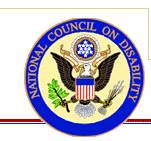|
from The Worldview Literacy Book copyright 2009 back to worldview theme #52 |
| Discussion
For many purposes, disability can be defined as "a physical
or mental impairment that substantially limits a major life
activity." How such
impairment is viewed or treated often depends on one's perspective.
Medical professionals see it as a defect that can be rectified
through medical intervention. Rehabilitation professionals want to treat
it through physical therapy. Religious
moralists might identify its cause with sin and its cure with prayer and
seeking redemption. Secular
humanists concerned about human rights might point the finger at
society, even to the extent of connecting the disability's origin with
labeling practices and its cure with the need for a change in societal
attitudes and the manmade environment. Throughout history, however,
disabled people have faced one constant: "Whatever the social
setting and whatever the disability, people with disabilities share a
common experience of social oppression" as historian Paul Longmore
puts it. In the fall of 1962 two students won
lawsuits, entered college, and became part of the history of human
rights' struggles. James
Meredith became the first Afro-American to attend the University of Mississippi, and Ed Roberts, left paralyzed from
the neck down by polio, was lifted out of his wheelchair and carried up
some steps to class at University of California at Berkeley.
While newspaper headlines proclaimed things like "Helpless
Cripple Attends UC Classes," Roberts watched blacks and women
challenge the similar assumptions of inferiority by those who would deny
their civil rights. Besides
obvious signs of prejudice, he saw subtle ones as well. "[I got]
more and more angry at the way people perceived me as a vegetable with
no future," he recalled. It
wasn't long before Roberts, and a handful of other wheelchair bound
students, realized that not only did peoples' attitudes toward them get
in their way, so did physical barriers all over the campus. They
decided to do something about it—the rest is history!
Some feel the American disability rights movement, which seeks to
improve the quality of life for disabled people by working to insure
that they have the same access to participating in society that other
people have, began that fall at UC Berkeley.
Others, pointing to Helen Keller (1880-1968), claim that its
history is much older. Whatever its origins, one of this movement's
first big issues was accessibility.
Those in wheel-chairs need ramps to enter buildings; blind people
need books in Braille or talking books; the hearing impaired need sign
language interpreters of oral presentations; etc.
The movement was bolstered by the formation of The National
Council on Disability (NCD) in 1973 (Figure #52b).
After decades of hard work by many groups, and with NCD help, in
1990 the movement celebrated passage of the Americans With Disabilities
Act (Figure #52a). It now
protects an estimated forty to fifty-five million disabled Americans
from discrimination (of an estimated 650 million disabled people
worldwide). |
Discussion—continued
Recent decades have seen the growth of another related movement:
the independent living movement. It
is based on beliefs that 1)
even the most severely disabled people should be able to live in the
community, rather than an institution, if they so choose, and 2) sick,
elderly or disabled people should a) have the opportunity and
responsibility to make decisions, and b) exercise the right to control
their own lives.
This movement has promoted, among other things, adaptive
technology and assisted living. The
former refers to technology which allows disabled people to perform
tasks that otherwise would be impossible and/or function more
effectively. The latter
often takes the form of supportive
housing with services. It represents a middle ground between long term
care in one’s home and institutionalized care.
Ideally those opting for this would 1) receive
care and supervision in a "home like setting,"
and 2) have some degree of
control over their environment and direction of services—which
typically are designed to provide flexibility.
As the percentage of the population classed as elderly steadily
grows in many Western countries, geriatrics, elderly care, and hospice
care have become increasingly important.
Likewise, the Independent Living Movement becomes increasingly
relevant (Figure #52c). As
people age, mobility naturally decreases and aches & pains multiply. Disease adds to their physical pain—all of which can lead
to a decreased quality of life and more suffering. Physical therapy and
palliative care can combat this. The
former employs exercises and techniques to reduce pain, inflammation,
and help people move better; the latter treats disease symptoms to
reduce suffering. Figure #52a
|
|
Figure #52b
|
Figure #52c
|
